Champions of the Grove
Galleries

September Elm (Ulmus serotina)
Spring Grove’s National Champion Tree! The Champion Tree National Register program is administered by American Forests. Their listing for September Elm reads as follows: This champion September Elm of Ohio made its debut on the National Register of Champion Trees in 2018. It is the largest known tree of its species in the country as reported to American Forests. This tree is recognized not only for its size but also the critical ecosystem services that it provides such a food and shelter for wildlife, its water purification abilities, and its role in absorbing CO2 from our atmosphere and storing carbon in its wood. In 2013, it measured to 93-inch circumference, 94-feet height and 56-feet crown spread listing a total of 201-points.
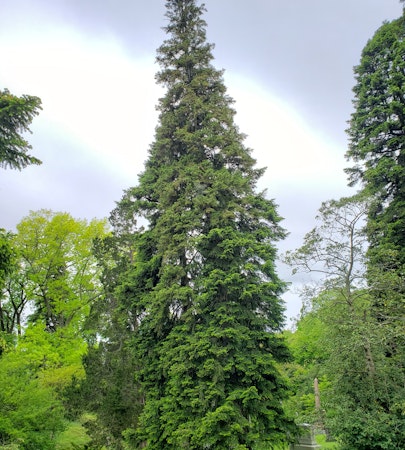
Cilician Fir (Abies Cilicicia)
Plants from the Caucasus region grow really well in this part of Ohio and Cilician fir is just one example. The only problem growing this fir is seed collection because firs generally keep their cones near their terminal height. They reside in Section 110 in a well-established colony where they are closer to the century mark in age. Their native range includes Lebanon, Syria and Turkey where they are listed as Near Threatened by International Union for the Conservation of Nature (IUCN). This state champion measures at 70-inches circumference, 96-feet tall and spreading 24-feet and rated at 172-points.
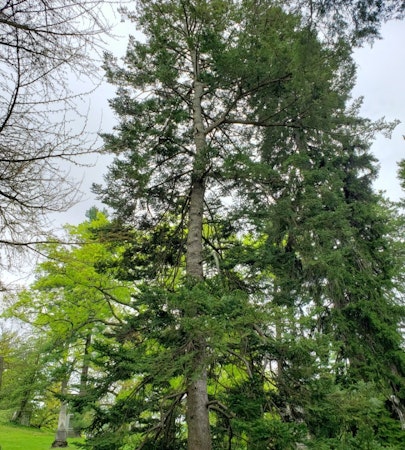
Korean Fir (Abies Koreana)
This species of fir is surprisingly listed as Endangered by International Union for the Conservation of Nature (IUCN) with three surviving populations in the south of the Republic of Korea. It prefers a temperate rain forest environment with plenty of snow. This specimen appears with a more open habit as it would in a native wood environment growing in Section 57, surrounded by other mature conifers of comparable height. Korean fir was described botanically by E.H. Wilson, the noted plant explorer, in 1920. The Conifer Society limits the height of Korean fir to 60-feet; ours was measured to 88-feet with a 79-inch circumference and a 42-foot spread rated at 177-points
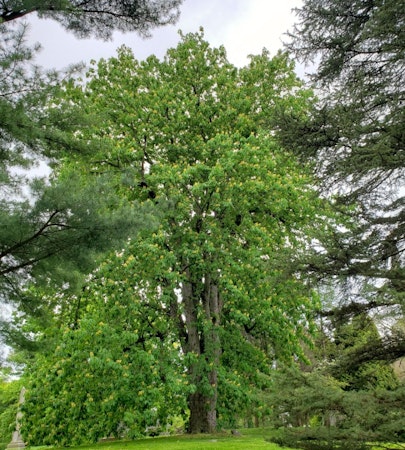
Yellow Buckeye (Aesculus flava)
This buckeye predates Spring Grove Cemetery’s founding in 1845 and was part of the Mill Creek floodplain plant community of Yellow Buckeye, American Elm and American Sycamore. Yellow Buckeye grows native in counties along the Ohio River going inland roughly in the unglaciated portion of Southeast Ohio. Our specimen measured a circumference of 178-inches, a height at 104 feet height and a spread of 77-feet for a total of 301-points. It can be found in Section 22.
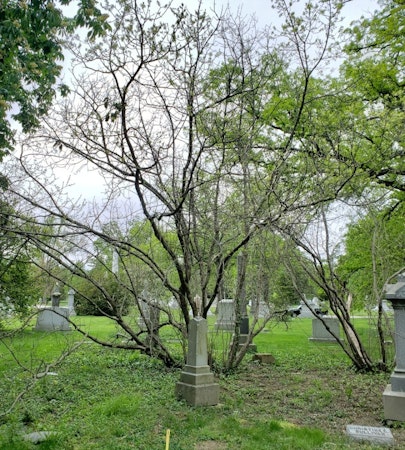
American Fringetree (Chionanthus virgincus)
Spring Grove’s champion American Fringetree can be found in Ohio’s southernmost counties but is adaptable throughout the state. Although its Asian cousin grows as a small tree, this taxon grows as a large multi-leader shrub that can be trained to grow as a small multi-leader tree with continuous effort. This specimen is in declining condition, but we have one other specimen that is larger than the designated champion. The current champion measured its largest leader to 27-inches, a height of 24-feet height and 22-feet for crown spread totaling 54-points. The champion tree has its boulder closer to it and away from the companion American Fringetree at the northern side of Section 101.
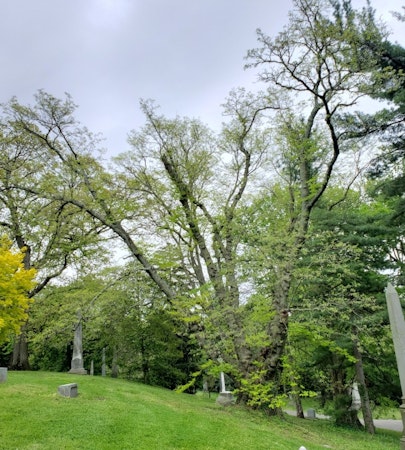
American Yellowwood (Cladrastis kentukea)
American Yellowwood is natively scattered along streams south and west of Ohio but has shown to be readily adaptable in Southwest Ohio. Spring Grove had the National Champion American Yellowwood until Hurricane Ike passed through Cincinnati. The specimen that survived the wrath of Ike is large enough to have the Ohio Champion title, but she is a bit worn. Tree bark has a gnarly texture quite different from the smoot silvery beech bark-like finish of a younger specimen. Our American Yellowwood is well protected on the lower slope behind White Pine Chapel on Section 69. If you look at all the American Yellowwood planted on the grounds, knowing they came from different sources at different times, realize that you will not find one flower out of its sequential of every other year. The fragrant white panicle flowering is a treat worth the wait. When last measured, this American Yellowwood garnered a circumference of 171-inches, a height of 63-feet and a crown spread of 63-feet earning 249-points.
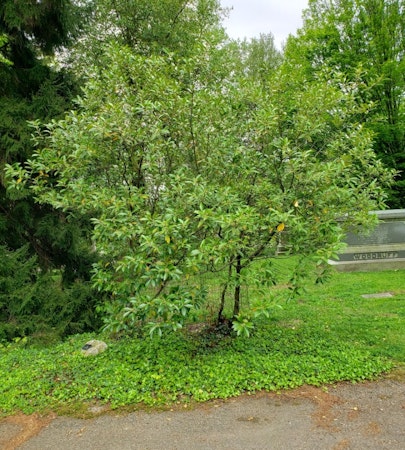
Devilwood, Wild-olive (Osmanthus americanus)
Devilwood is a broadleaf evergreen shrub that is highly underutilized in the ornamental plant industry. Specimens at Spring Grove grow in dense shade to full sun and in a variety of soil textures as long as they drain well. The national champion resides in Wakulla, Florida showing the growing range of Devilwood. Flowering is insignificant to its broadleaf character. Our champion measured to a 7-inch circumference, 12-foot height and 8-foot spread earning 21-points and can be seen in Section 54. (The national champion is rated at 92-points)
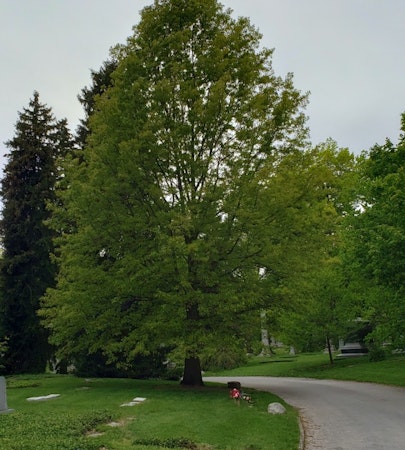
Nuttall Oak (Quercus texana)
The display sign doesn’t show the current accepted botanical name for this specimen. Unfortunately for Latin-prone plant people, this oak has been bounced around the spectrum of red oak group trees. Nuttall Oak is native to the lower Mississippi valley but demonstrates good tolerance for northern conditions. At first glance you may think you are viewing a red oak pin oak, scarlet oak or a Shumard oak which explains the fact that oaks in North America freely hybridize. This specimen measured a circumference of 57-inches, 45-foot height, 37.5-foot crown spread and came out with 111-points and is located near the barn at the north end of Section 88.
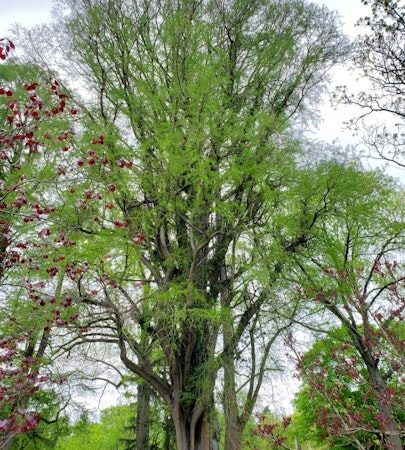
Baldcypress (Taxodium distichum)
This tree is the Queen of the Swamp! Knees are the noted feature that allow the genus Taxodium to thrive in standing year-round water. These porous appendages connect to the roots and allow for aerobic respiration. The tallest knees grow off specimen around Cedar Lake in Section 21 but the state champ is across the road in Section 20 near the Fleischmann Mausoleum. They seem to get confused with Dawn Redwood but looking at the leaf and bud arrangement shows that they are alternately set on Baldcypress and oppositely set on the former. Baldcypress grow along the Atlantic and Gulf Coasts and up the Mississippi Valley into Indiana. The deep sinus fissures complicate the circumferential measurement but its recorded at 212-inches. The height measured 113-feet with a crown spread of 61-feet and a total of 340-points.
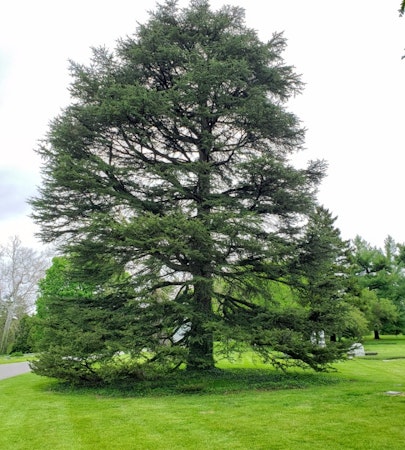
Cedar of Lebanon (Cedrus libani)
The first Cedar of Lebanon planted at Spring Grove died from lack of cold hardiness. Arnold Arboretum sent 19 cuttings of Cedrus libani collected from northern range specimens in the Taurus Mountains that have greater cold hardiness. That was in 1930, giving Spring Grove a collection of these cedars that will not likely be superseded in state champion status for quite some time. The oldest recorded specimen in the Lebanon population was 3,000-years. Our Cedar of Lebanon population has yet to produce the horizontal habit characterized on Lebanon’s national flag. International Union for the Conservation of Nature (IUCN) lists Cedrus libani var. libani as Vulnerable not recognizing the northern variety, Cedrus libani var. Stenocoma. Measurements for this cedar were 122-inches on circumference, 64-feet in height, 46-feet in crown spread and 197-points. It is conveniently located along the road west of Willow Water Lake next to the state champion Dawn Redwood in Section 18.
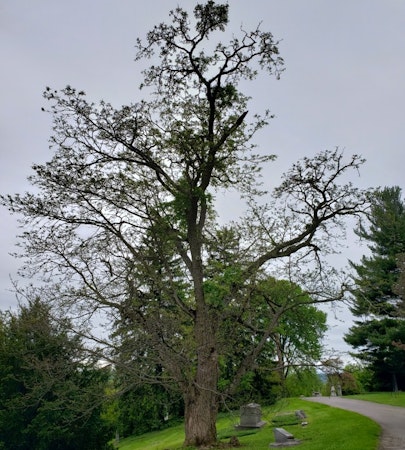
Amur Corktree (Phellodendron amurense)
This native of Northern China and Japan is invasive but hasn’t spread at the rate of the Asian honeysuckles and Bradford pear. Dioicous flowering gives the chance of growing male cloned specimens but they may have the same reversion factor of other dioicous trees. The tree is noted for its deeply furrowed corky bark and was a highly recommended tree before invasiveness became an issue with ornamental horticulture, although the floral quality has little impact. This champion specimen has a circumference of 157-inches, 46-feet in height, 64-feet spread and 219-points. Finding this tree is easy along the road in Section 95.

Oriental Spruce (Picea orientalis)
This tree is said to have arrived at Spring Grove in the quantity of 500 and E.H. Wilson commented on a visit here that he thought our specimens were among the first ones introduced to the United States. It is definitely the friendliest of all the spruce species growing at Spring Grove with its short, plump and round tipped needles. The tree is described botanically as pyramidal in shape but that pertains only to the terminal area. The remaining portion of the tree is columnar and in time will reach 100-feet in height. This native of the Caucasus is another example of ease of culture those plants have in this part of the world. Our champion specimen reads at a 81-inch circumference, 89-foot height, 26-foot spread and rated at 177-points. The champion tree is in a small colony of like trees at the northern part of Section 47.

Tigertail Spruce (Picea polita or P. Torano)
Tigertail Spruce is found through a wide range in Japan and is noteworthy for its attractiveness in foliage and persisting cones. However, a sudden encounter with tigertail spruce will induce pain from the spiny stiff needles. The older specimen in the southwest part of Section 101 was complimented with two companions to flank it some years later, seeing that they are much shorter in height. Its cold tolerance, coming from mountainous areas up to 4800-foot elevation will give it a more northern range in the Americas. International Union for the Conservation of Nature (IUCN) lists Tigertail spruce as Vulnerable which is above Least Concern but less than Endangered. Our champion specimen measured a 78-inch circumference, 60-foot height, 38-foot crown spread and rated 147-points.
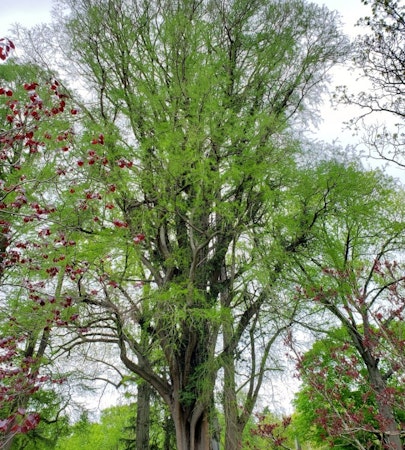
Sawtooth Oak (Quercus acutissima)
Literature on this tree consistently rates it as being invasive but fortunately that is not the case for Southwest Ohio. Specimens are planted in different regimes throughout Spring Grove with no reports of seedling occurrence. The bark has a telltale orangish furrow and the foliage describes its namesake; unique enough to not resemble any of the chestnuts. Sawtooth oak doesn’t appear to be an aggressive growing oak. Our tallest specimen is just shy of 80-feet in height but the one invasive quality that may raise a discerning eye is that it is the last oak to retract its seasonal foliage. Located adjacent to the Fountain of Remembrance and opposite the southeast corner of the Lawn Crypt, this champion specimen has a circumference of 91-inches, a crown spread of 59-inches and was rated at 184- points.
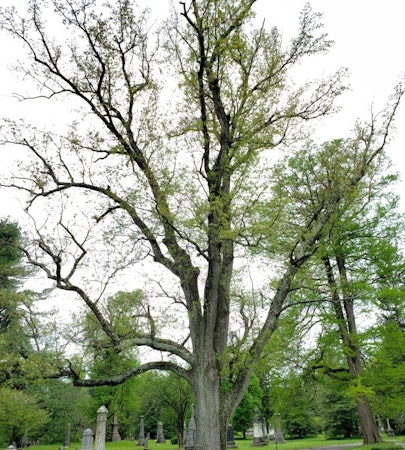
Turkey Oak (Quercus cerris)
Not to be confused with the American turkey oak (Quercus laevis), this Caucasus native also ranges through southern Europe. The bark pattern occurs in raised checker plates as described by Michael Dirr. The wetter seasons seem to be inducing a decline in the crown of this specimen. Another specimen of lesser size better condition is situated in Section 111 opposite Section 112 and the Main Border. The champion specimen located along the road on the northeastern side of Section 42 will be missed when the decline becomes a hazard. It measured 147-inches circumference and at its peak, 90-feet in height and 84-feet in crown spread and had 258-points.
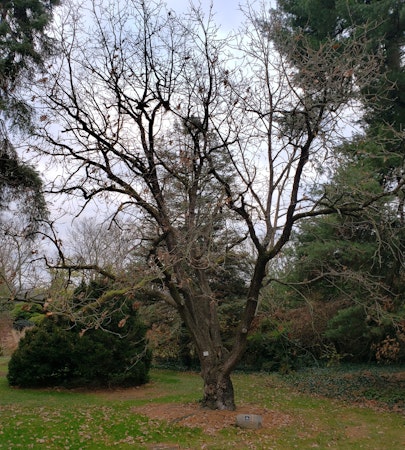
Hungarian Oak (Quercus frainetto)
This oak is included with English Oak (Quercus robur), providing the lower tannin wood that produces French oak wine barrels. Looking at the champion specimen, one would question the use of this oak growing in its short branching habit for the wine industry. Being in the white oak group, this taxon has rounded leaf lobes with a leathery glossy texture seen in oak from warmer regimes. Hungarian oak has a wide range from Italy to the Caucasus in Turkey. If our specimen could grow straight and tall, it could reach 125-feet in height. Our specimen measured at a circumference of 93-inches, 34-feet in height, 38-feet in crown spread and rated at 136-points. The champion tree is located opposite the Garden Mausoleum near the west entrance to the gazebo in the Garden Courtyard. A companion specimen of similar habit is located at the northwest corner of Section 60 along the yellow painted line road.
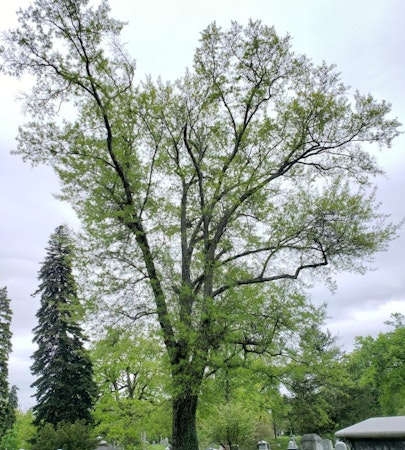
Water Oak (Quercus nigra)
This native Eastern United States native is considered a non-native entry on the Ohio Champion Tree list. Its range approaches Ohio in Kentucky but ventures up the East Coast to New Jersey. It’s described as a weed tree in Georgia but the flowers must freeze in this part of Ohio because the nut (acorn) is not seen on the two large specimens at Spring Grove. The unique foliage has three rounded terminal lobes on a slender blade. The tallest trees reach over 100-feet in height but our champion specimen was measured to 80-feet. The champion specimen in Section 113 measured 138-inches in circumference, 81-feet in crown spread and 238 points. The backup specimen in Section 30 at 201-points is the second rated water oak in Ohio.

Ivy-leaf Maple (Acer cissifolium)
Asian maples have the same promiscuous behavior of freely hybridizing across species that is seen in our North American oaks. Acer cissifolium is a trifoliate leaflet maple native to mountainous sites in Japan and typically grows as a small tree or a large shrub. It produces a delicate orange-red fall color and displays a smoother bark with complex branching in the dormant season. Spring Grove’s specimen appears to be in the 50-plus year range. Measurements taken several years ago were a 66-inch circumference, a rounded 25-foot height and a 19-foot spread with just enough open canopy to allow vehicle traffic clearance in Section 95. This ivy-leaf maple rated 80-points and is one of many specimens listed on the Ohio Champion Tree list that have no second-place entries.
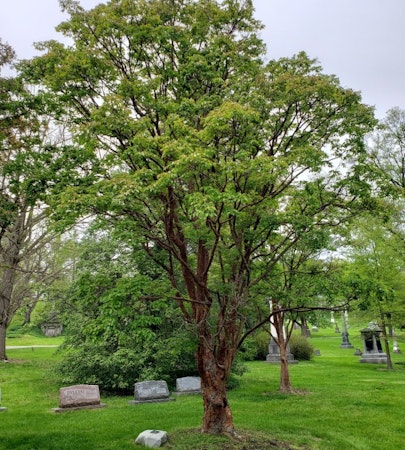
Paperbark Maple (Acer griseum)
Paperbark maple was collected by E.H. Wilson and introduced to the United States in 1901. Using the growth rate calculator multiplied to the tree diameter of this specimen, the approximate tree age places it at or near the introduction date. Only recently has more germplasm been wild collected from this taxon allowing for greater genetic diversity in propagation. International Union for the Conservation of Nature (IUCN) lists Acer griseum as Endangered with a current population between 220 to 250 individual trees remaining in-situ (in the wild). Our champion tree factored with a circumference of 51-inches, 25-foot height, 19-foot crown spread totaling 80-points. This specimen can be seen in Section 67 flanked by two younger paperbark maple specimens.
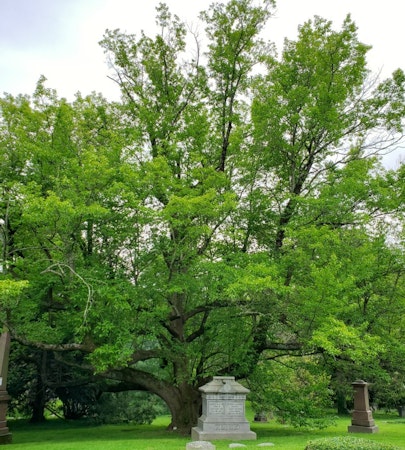
Hardy Rubber Tree (Eucommia ulmoides)
This tree is widely cultivated but is listed as Vulnerable by International Union for the Conservation of Nature (IUCN). Missouri Botanic Garden’s Plant Finder states it is extinct in its range in central China. Its unique feature is that it contains up to 3% latex and can be seen when gently splitting a leaf or fruit capsule. This taxon however is not used for rubber production but does have some medicinal use in Chinese medicine. Our specimen is fairly large at 130-inches circumference, 60-feet in height, 67-feet in crown spread and 210-points. This tree hides to the west of the shelter house in Section 53 where one can walk under the canopy and find seedlings that don’t venture any farther than the distance they fell from the tree. No animals consume the seeds preventing them from being vectored outward.
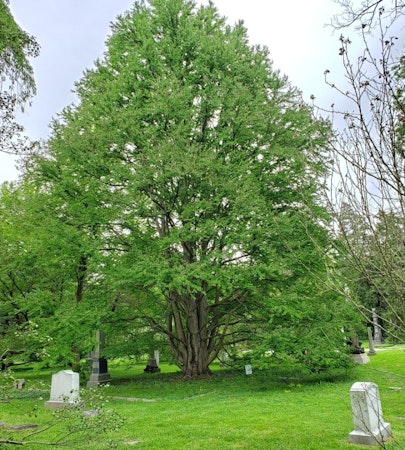
Katsuratree (Cercidiphyllum japonicum)
Native to China and Japan, this tree arrived in cultivation by 1865 but the two specimens at Spring Grove are not quite that old. The tree loves to produce multiple leaders but maintains a solid architecture that doesn’t fail structurally. The original champion tree is located at the northern tip of Section 22 but was defrocked by another entry on the state champion tree list. Having another specimen in Section 53 proved to be beneficial because it staged a countercoup and returned the state champion title to Spring Grove with a measurement of 180-inches circumference, 78-feet in height, 67-feet in crown spread and 274-points
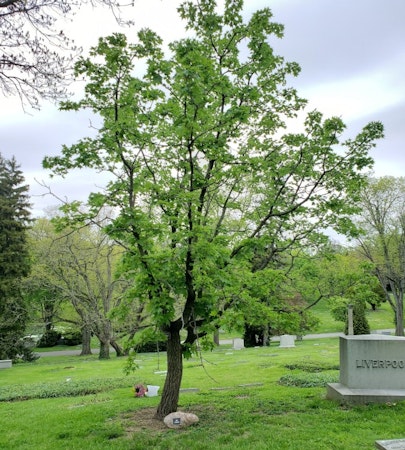
Castor-aralia (Kalopanax pictus aka K. septemlobus)
Castor-aralia has an extensive range in northeastern Asia, from Sakhalin and Japan west to southwestern China as a slower growing tree in Southwest Ohio. The most interesting feature is randomly placed thorns from end to end on this tree. They are more pronounced on the foliar portions but show caution before leaning against or trying to climb this tree. Leaves resemble castor-bean foliage with seven lobes per leaf. Although literature suggests a 60-foot height, the growth rate suggests something lower. Spring Grove’s specimen measured a 24-inch circumference, 19-foot height, 18-spread with 47-points. This smallish tree can be found in Section 115 across from Section 117.
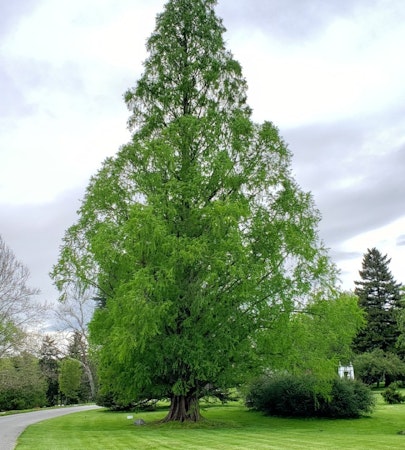
Dawn Redwood (Metasequoia glyptostroboides)
This living fossil is listed as Endangered by International Union for the Conservation of Nature with the tree surviving in 18 fragmented sites. Discovered in the 1940’s, Arnold Arboretum funded an expedition that collected 500-grams of seed and distributed germplasm throughout its growing region. The specimen at Spring Grove came from the original 1948 distribution. Dawn redwood is native to Hunan, Hubei, Chongqing provinces in China. Subsequent collections in the 1980’s proved that the initial collection secured 80% of the genetic spectrum. Spring Grove’s champion specimen measured 199 inches circumference, 94-feet in height, 51-feet in crown spread and 305-points
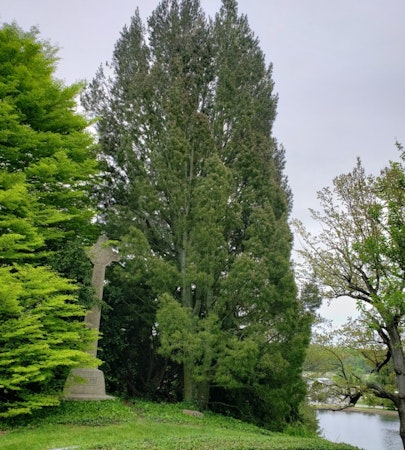
Lacebark Pine (Pinus bungeana)
Spring Grove’s champion lacebark pine was planted in a site that was specifically designated with a special meaning. The adjacent family lot belongs to the Rowe family whose namesake is the recognized conifer garden of Rowe Arboretum. This stately specimen is accented by a large carved Celtic cross. Lacebark pine is unique for its patchwork of white, olive, light purple and silver to milky white bark. Mature trees create an openness to accentuate the bark pattern making it one of the showiest tall conifers. Our champion specimen hides behind the waterfall in Section 18 but is readily visible from the road above. A 60-inch circumference is set with a 54-foot height and a 25-foot crown spread yielding 120-points.
What is a Champion Tree?
A Champion tree is a tree that measures out to the highest number of points for its taxon or species. Measurements are taken at 54” DBH (Diameter Breast Height) above soil grade earning (1) point per inch diameter, (not circumference). The height is measured and calculated with (1) point per foot. The crown spread is the two cross measurements with the average used and multiplied by ¼ point (.25) per foot. Add these three values and compare it with the Ohio Champion Tree list value administered by Ohio Department of Natural Resources. Contact the person listed on the Ohio Champion Tree site if your tree’s point value is within 20 points or so of the listed champion. Your contact will schedule an appointment with you when available to verify and officially measure your tree for the state record.
American Forests, the organization that administers the Champion Tree National Register takes their data from State Champion Tree publications to formulate national champion trees. They have a detailed tree measuring publication available at this link: https://www.americanforests.org/wp-content/uploads/2019/07/AF-Tree-Measuring-Guidelines_MW.pdf
Our Champion Trees are marked with a small boulder having a metal photo sign reading, “State Champion”